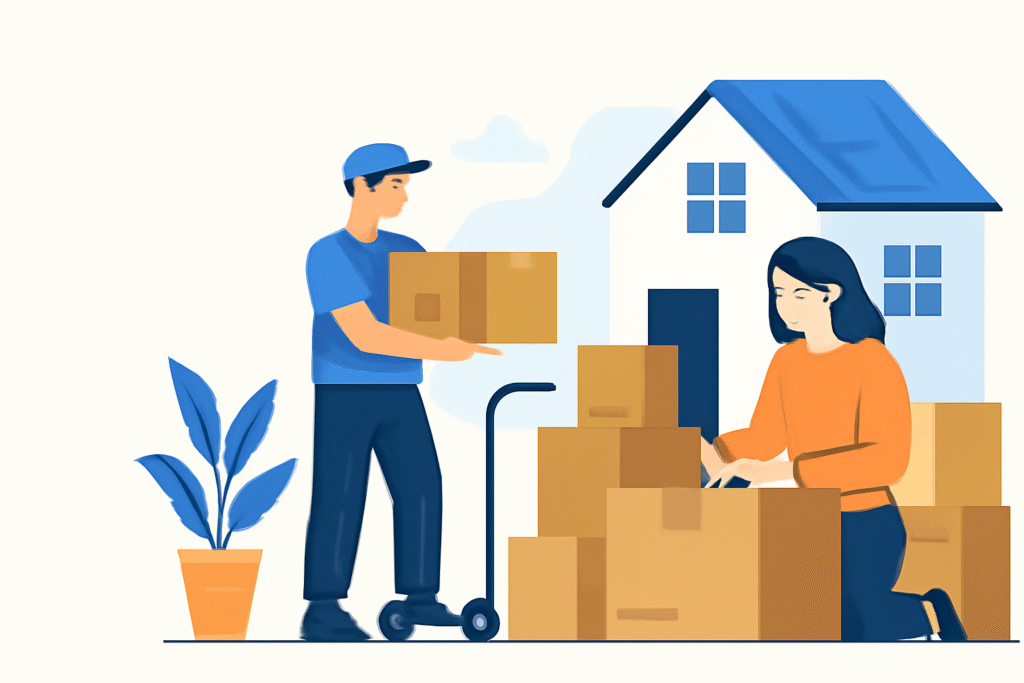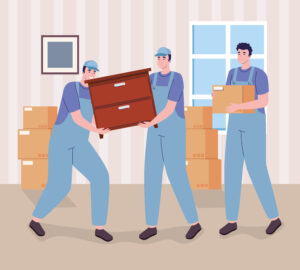If you’ve ever moved house, you already know it’s one of those life events that sounds exciting until you’re knee-deep in boxes wondering how you’ve accumulated so much stuff. The truth is, preparing for a move doesn’t have to feel like chaos; it just needs a bit of planning, organisation, and the right moving checklist.
Whether you’re relocating across town or starting over in a brand-new city, a solid moving schedule helps you stay ahead of the curve. Think of it as your game plan, the difference between a calm, controlled transition and a frantic, last-minute scramble.
Moving house can be stressful, sure, but it’s also a fresh start, a chance to reset, reorganise, and build a home that fits the next version of you.
Why Moving Is Stressful
Let’s be honest, moving ranks right up there with breakups and tax season on the stress scale. Between packing, paperwork, and trying not to lose your sanity (or your scissors), it can feel like a marathon of mini-crises.
The biggest culprits are disorganisation and poor timing. Without a plan, you’re left scrambling for packing materials for moving, running out of tape, or forgetting key moving day essentials like your charger, toothbrush, or your patience.
But here’s the good news: when you prepare properly and follow a simple strategy, that mountain of stress shrinks fast. A solid moving checklist gives you clarity, helps you delegate tasks, and ensures that when the big day comes, you’re ready for it.
What to Expect During the Move
This guide covers everything from early prep to post-move settling. We’ll talk packing tips, moving company booking, and even changing address post office steps, plus a dozen small details that make a huge difference.
By the time you reach the end, you’ll not only know how to move house efficiently, you’ll also know how to keep your sanity intact while doing it.
Preparation for Moving
Start Early: How to Plan for a Smooth Move with Clear Moving Timeframes
Every smooth move starts early. Give yourself at least four to eight weeks to plan depending on the size of your home. Map out a moving schedule that includes weekly tasks: getting quotes, gathering supplies, and booking your removalists.
Use a moving checklist to track it all. Start by listing everything you need to do, then divide it into clear moving timeframes: two months before, one month before, one week before, and the day of. You’ll feel far less pressure when each task has its moment.
The earlier you start, the easier it is to fix surprises like utility delays or missing boxes.
Booking the Right Moving Company and Getting Reliable Moving Quotes
Not all professional movers are created equal. Do your research before you sign anything. Ask for moving quotes from at least three companies, read reviews, and don’t be shy about asking questions.
Good moving company booking habits mean knowing exactly what’s included: insurance, packing services, disassembly, and travel time. Cheaper isn’t always better; look for reliability, communication, and care.
If you’re hiring moving companies, confirm your booking at least three weeks before your date. That way, you’re not stuck begging for last-minute help when everything’s booked solid.
Essential Packing Materials for Moving
You can’t pack smart without the right tools. Invest in sturdy moving boxes, bubble wrap, tape, and labels. Skip the flimsy supermarket boxes and get purpose-made packing materials for moving; your back and your fragile items will thank you.
Don’t forget the packing supplies that make life easier: box cutters, markers, stretch wrap, and zip-lock bags for screws and cords. Having these on hand early keeps you from doing emergency hardware store runs at midnight.
Managing Time Off Work for Moving and Arranging Care
If you can, schedule time off work for moving. It’s nearly impossible to juggle meetings and moving boxes at the same time. A day or two on either side of your move lets you pack, unpack, and breathe.
If you have kids, arranging child care on moving day ensures they’ll be safer and less bored with relatives or friends. Same goes for pets. Arranging pet care for moving keeps them calm and out of harm’s way while doors are open and boxes are flying.
Decluttering Before the Move
Why Decluttering Before a Move Matters
Before you wrap a single plate, take a deep breath and a long, hard look at your stuff. Decluttering before a move isn’t just about saving space; it’s about saving time and money. The less you move, the cheaper your moving costs.
Think of it as a mini-makeover for your life. Donate what you don’t love, sell what you don’t need, and recycle what’s broken. Downsizing tips like the “three-box rule” (keep, donate, toss) can work wonders when getting rid of stuff before moving.
Step-by-Step Declutter Your Home Guide
Start small. Pick one room at a time and don’t try to do it all in just one weekend. To declutter your home, ask: have I used this in the past year? Would I buy it again? If not, it’s time to let it go.
Use bins or boxes for sorting and label them clearly. It’s all part of organizing before moving. Be ruthless but realistic; sentimental items can be revisited after you’re settled.
Involving Kids in Decluttering and Family Fun
Decluttering doesn’t have to be a solo mission. Make it a team effort. Turn on some music, hand out boxes, and give everyone ownership of their space.
Involving kids in decluttering teaches them responsibility and decision-making. Use fun family decluttering tips like giving each person a “ten-minute tidy challenge” to make the process quick and painless.
Packing Tips
Smart Packing for a Move
Efficient packing for a move is all about strategy. Don’t just throw things into boxes. Start with off-season clothes and non-essentials, then move toward daily items.
Use quality moving boxes and keep weight balanced: heavy stuff at the bottom, lighter on top. Create a colour-coded system by room, and write what’s inside each box. This simple packing tips for moving day trick saves hours of guesswork later.
Packing Strategies: Room-by-Room or Item Type
Here’s the big debate: do you pack by room or by category? The answer: both.
Room-by-room packing works well for kitchens, bathrooms, and kids’ rooms. It keeps everything organised for unpacking. But packing strategies by item type (like all books, all linens) are great for keeping weight and fragility consistent. Mix and match depending on your home’s layout.
How to Pack Fragile Items and Heavy Goods
Use small boxes for packing heavy items and never overfill. For breakables, wrapping is non-negotiable. Use bubble wrap, towels, or clothes to cushion things.
Learning how to pack fragile items properly can save you heartbreak. Stack plates vertically like records, pad glasses individually, and mark every side of the box as “FRAGILE.” This ensures packing fragile items safely without panic later.
Labeling Moving Boxes and Organisation
Proper labels make moving day smooth. Clearly mark each box with the room name, contents, and priority (for example, “Open First”).
This step is gold when you’re exhausted and staring at twenty unlabelled boxes. Use colour stickers or markers; it’s one of the simplest packing tips for moving day that truly works.
Labeling moving boxes isn’t glamorous, but it’s a sanity saver.
Moving Day Essentials
Packing an Essentials Bag for Moving
Your essential bag for moving is basically your emergency kit. Include toiletries, chargers, snacks, important documents, basic tools, and a change of clothes.
Keep it with you, not on the truck. When you arrive, you’ll have everything you need to survive your first night: your toothbrush, kettle, and sanity. This is your ultimate moving day essentials hack, and it makes unpacking essentials feel a lot more manageable.
How to Stay Organized on Moving Day
Moving day checklist tasks can pile up fast, so create it the night before: confirm removalists, double-check keys, and pack any last-minute items.
Learn how to stay organized on moving day by assigning roles: one person for logistics, another for cleaning or kid wrangling. These small moving day tips make everything smoother.
Dismantling Furniture for Moving and Preparation
Disassemble beds, tables, and shelving the night before. Label hardware in bags and tape them to the furniture they belong to.
This step in preparing for the move saves time and confusion later. Have basic tools ready: a screwdriver, Allen keys, and a wrench. Add them to your moving day essentials so you’re not digging through boxes when you need them most.
Hiring Moving Companies and Supervising Professionals
If you’re hiring moving companies, greet the crew early, walk them through your home, and highlight fragile or high-priority items.
Professional movers are pros, but supervision helps prevent mix-ups. Be available for questions, offer water, and check rooms before they leave. You’ll keep things smooth while supervising movers efficiently.
Unpacking and Settling In
Unpacking Tips: Where to Start
When you finally arrive, take a deep breath. You made it. Now comes phase two: unpacking.
Start with the essentials: kitchen basics, bedding, and toiletries. Leave décor for later. Follow simple unpacking tips like working room by room. Use smart unpacking strategies to prioritise what actually helps you live comfortably first. Keep unpacking essentials handy.
Organizing Your New Home
Once the boxes are out of the way, it’s time to make it feel like home. Organizing your new home starts with function: where does everything actually belong?
Take your time. Focus on high-use areas first. A week of good post-move organization sets the tone for your whole house. That’s how you ease into settling into a new home instead of rushing through it.
Dealing with Post-Move Stress
After the adrenaline fades, it’s normal to feel tired or overwhelmed. Dealing with post-move stress means giving yourself permission to rest.
Unpack slowly, maintain routines, and connect with your new surroundings. Meditation, music, or walks around the block help reset your brain. Learning how to stay calm during a move is about pacing yourself, not perfection.
Changing Address and Notifications
How to Change Address Post Office
Don’t let your mail go to your old place. Visit the post office to change address for mail and set up redirection for at least three months.
Notify utilities, banks, and subscriptions. It’s easy to forget small things, so use a checklist when notifying the post office of your move.
Updating Important Documents After the Move
After you’ve moved, update driver’s license, moving, electoral roll, and insurance. Forgetting to change the address on the driver’s license can lead to fines, so make it a priority.
Set aside time for updating important documents; it’s tedious but crucial for smooth transitions.
Transfer Utility Services Before You Move
Arrange to transfer utility services at least a week before your move. Contact providers to transfer electricity and gas, update internet plans, and schedule disconnection dates.
Doing this early ensures your new home’s lights turn on before you arrive, a small detail that saves big frustration on day one. Proper handling of moving utility services keeps everything seamless.
Professional Help
When to Hire Professional Movers and Packing Services
Sometimes it’s worth the money. Professional movers and packing services save hours of work, especially for large homes.
If time’s short or you’re overwhelmed, hiring moving companies to handle everything from wrapping to unloading keeps stress low and efficiency high.
Renting Storage Units for Moving
Between selling and buying? Look into renting storage units for moving. Temporary storage solutions are perfect for decluttering or holding furniture mid-move.
Many companies now offer flexible, secure storage units for moving with 24-hour access and temperature control.
Understanding the Cost of Hiring Movers
The cost of hiring movers varies; expect around AUD $140–$240 per hour for professional packing services staff, depending on distance and size.
Request transparent moving costs upfront so there are no unpleasant surprises.
Post-Move Considerations
Home Maintenance After Moving
Once you’ve unpacked, do a quick check of your new property: plumbing, smoke alarms, and heating.
Keeping on top of home maintenance after moving ensures safety and comfort while helping you settle into a new home smoothly. Consistent post-move home maintenance prevents future headaches.
Exploring Your New Neighborhood
Get outside! Walk around, visit cafés, explore parks, and chat with locals. This is the fun part of settling into a new neighborhood: discovering your go-to coffee spot or the fastest route to the beach.
The more you invest in exploring your new neighborhood, the faster it feels like home. Soon, you’ll be getting familiar with your new neighborhood like a local.
Meet New Neighbors and Build Community
Building relationships is key. Knock on a few doors, join local groups, or attend community events.
To meet new neighbors means to build a sense of belonging. Whether it’s a friendly wave or joining a weekend BBQ, small acts of connection make community integration after moving feel effortless and show you how to make new friends in a new neighborhood.
Conclusion
Here’s the truth: moving house will always take effort, but it doesn’t have to drain you. With the right plan, good organisation, and realistic expectations, the process becomes manageable and even enjoyable. Preparation is everything. When you follow a solid moving checklist, pack smart, and give yourself enough time, you’ll find the stress starts to melt away.
Think of your move as more than just boxes and bubble wrap; it’s the start of a new chapter, a chance to refresh your space and mindset. The goal isn’t a perfect move, it’s a smoother, calmer transition that lets you actually enjoy the excitement of settling into your new home.
If you’d rather skip the heavy lifting (literally), let the professionals handle it. Ashville Removals specialises in stress-free moving experiences across Australia. Our friendly team knows how to pack, lift, and transport everything safely, saving you time, effort, and a whole lot of back pain. Whether it’s a local move or a long-distance relocation, we will handle the details so you can focus on your fresh start.
Start planning today and make your next move the easiest one yet with Ashville Removals by your side. Call us today and book your move!






